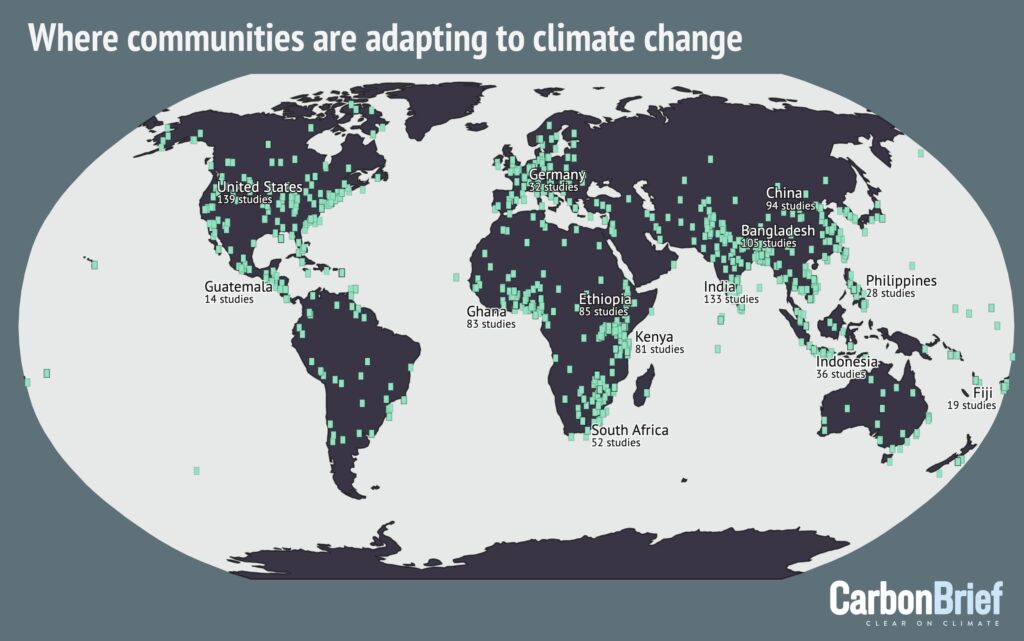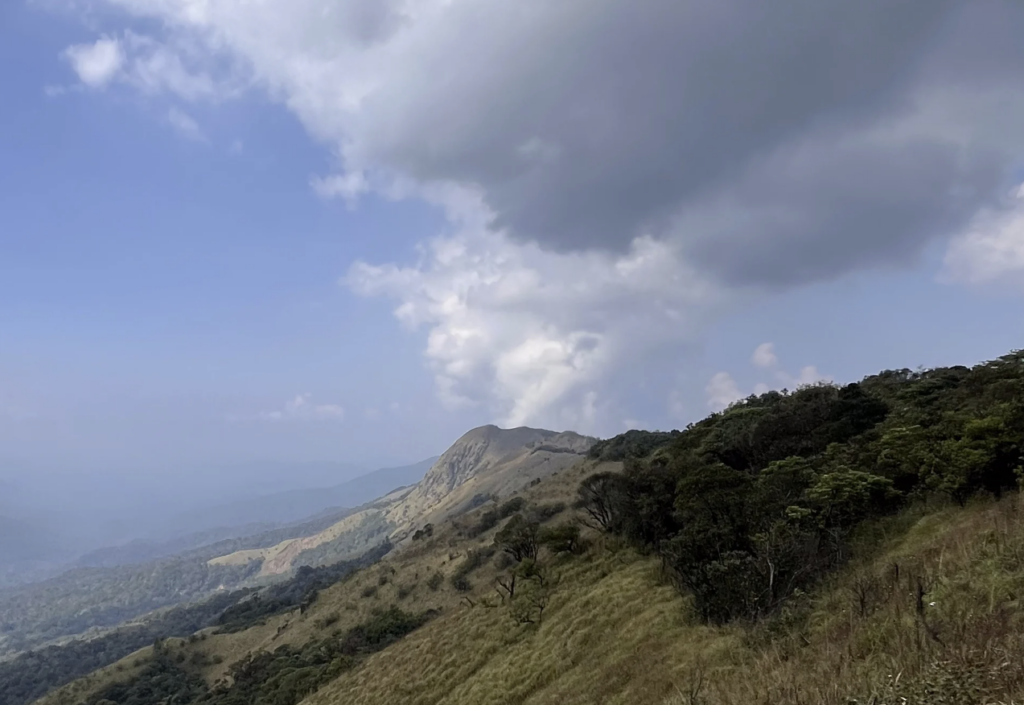Welcome to Carbon Brief’s DeBriefed.
An essential guide to the week’s key developments relating to climate change.
This week
California burning
‘MOST DESTRUCTIVE’: At least 10 people have been killed and more than 9,000 buildings have been gutted in wildfires “scorching communities” across Los Angeles, the Los Angeles Times reported in its latest update on Friday. There are multiple fires burning across LA county, including the 15,800-acre Palisades fire that CNN described as the “most destructive fire in LA history”.
INFERNAL LA: LA’s firefighters are struggling with water supplies and are “unaccustomed to fighting multiple blazes at once”, BBC News reported. “There are not enough firefighters in all of LA County to address four separate fires of this magnitude,” LA county fire chief Anthony Marrone told the outlet. The Los Angeles Times said the fires have already caused at least $50bn in losses, which could also threaten hundreds of thousands of Californians who already struggle to “find and keep affordable homeowners insurance”.
TINDERBOX CLIMATE: Many outlets examined the climate “drivers” of the wildfires. The Washington Post said the flames were fanned by a “life-threatening and destructive” windstorm. BBC News said that California’s decade-long drought and a four-inch decline in LA’s annual rainfall had left the region dry and so “particularly vulnerable” to the spread of fires. The Guardian cited research finding that climate change has caused a 172% increase in California’s burned area since the 1970s.
Hello, goodbye
CAN’T TOUCH THIS: US president Joe Biden announced a “permanent stop” to new oil and gas drilling across more than 625m acres of US coastal waters, thus protecting 20% of the seabed, the New York Times reported. While Biden called the move a “climate imperative”, the Guardian pointed out that the law does not explicitly allow presidents to “unilaterally reverse a drilling ban without going through Congress”. Alaska, meanwhile, sued the Biden administration over oil and gas drilling leases in the Arctic, Reuters said.
TILTING AT WINDMILLS: In a “lengthy tirade against windpower”, US president-elect Donald Trump pledged that no wind farms will be constructed during his second term, threatening billions of dollars in planned projects, Bloomberg reported. Earlier in the week, Trump criticised the UK government’s energy policy, with a call to “open up” North Sea oil and gas production and “get rid of windmills”, Reuters reported.
HYDROGEN BREAK: After “months of intense lobbying”, the Biden administration finalised rules that “offer billions of dollars in tax credits to companies that make hydrogen”, the New York Times reported. The rules include relaxed criteria for the “struggling sector” to claim tax credits, the Financial Times wrote.
Around the world
- RECORD HEAT: Multiple climate datasets have confirmed that 2024 was Earth’s hottest year on record, with temperatures breaching 1.5C above pre-industrial levels for the first time, BBC News reported. Carbon Brief has all the details in its latest state of the climate” quarterly update.
- ADIEU, TRUDEAU: Justin Trudeau announced his resignation as Canada’s prime minister on Monday, ending a near-decade “of [the country’s] most climate-conscious federal government”, but with a “physically enduring legacy” of oil pipeline expansions, the Narwhal reported.
- MECCA FLOODS: Torrential, unseasonal rain lashed cities in Saudi Arabia on Wednesday, with the holy city of Mecca facing the “worst floods”, Down to Earth reported.
- WATER WOES: Last year, water-related disasters claimed more than 8,700 lives, drove 40 million people from their homes and caused $550bn in economic damage, according to the 2024 Global Water Monitor report covered by the Guardian.
- TAPS TURNED: Climate-induced sea level rise will “overwhelm” many of the world’s biggest oil ports, including Houston, Rotterdam and Ras Tanura, according to new analysis by cryosphere scientists who described the threat as “ironic”, the Guardian said.
- BANKS BOUNCED: Bloomberg reported that there are “zero” big Wall Street banks left in the Net-Zero Banking Alliance, after the biggest US bank JP Morgan quit the UN-backed climate coalition weeks before Trump assumed office.
10 days
The time it took for the world’s richest 1% to “burn through” their 2025 “share” of the global “carbon budget” for keeping warming under 1.5C, according to new Oxfam analysis.
Latest climate research
- Arctic marine heatwaves could intensify “on orders of magnitude” during the rest of this century under climate change, posing “major challenges for Arctic ecosystems”, according to new Nature Climate Change research using high-resolution climate models.
- A new study in Science estimated that building materials used in new construction could potentially store 16bn tonnes of CO2 every year.
- New research in Nature Cities found that high-income city dwellers in China were more likely to “order in” food during heatwaves, revealing the “transfer of heat exposure from consumers to delivery riders.”
(For more, see Carbon Brief’s in-depth daily summaries of the top climate news stories on Monday, Tuesday, Wednesday, Thursday and Friday.)
Captured

The map above uses squares to illustrate 1,682 studies where communities are taking on-ground measures to adapt to climate change, from the islands of Tuvalu to the high mountains of Nepal. These studies were collated as part of the most comprehensive assessment to date of the scientific literature on climate adaptation. Carbon Brief has produced an interactive article based on the database that pulls out some of the key findings and explores global trends.
Spotlight
What listening to crickets reveals about rainforest change
This week, Carbon Brief speaks to scientists studying what sounds from wildlife can reveal about change in an Indian rainforest.
On Christmas night in Coorg (Kodagu) – prime coffee country in India’s Western Ghats biosphere – the rainforest was anything but silent.
The night air – though drier than it should be this time of year – was charged with an electric score of cricks, chirps, trills, hisses, croaks, whoops and whistles.
The Western Ghats is one of the “hottest hotspots” of biodiversity on Earth, hosting 325 globally threatened species. Coorg, on its eastern slopes, is a micro hotspot that receives more than 4000mm of rainfall on average and is the source of the Kaveri river, whose waters are bitterly disputed among the south Indian states seeing increasingly hotter summers and devastating floods.
A short climb reveals physical scars of extreme weather: beyond thick canopies are hilltops bearing gashes from devastating landslides in 2018 that killed 20 people and displaced 18,000.
To understand the less-visible impacts of climate and land-use change on non-human species in Coorg’s dense forests and plantations, sound has emerged as an important tool.
Biodiversity symphony
Bio-acoustics is the science of sounds produced by biological systems and what they react to. Prof Rohini Balakrishnan at the Indian Institute of Science described her work as a “bridge between symphony, cacophony and silence” and said that there are “signatures” of land degradation in sound that photographs cannot capture. She told Carbon Brief:
“When we first came to the Western Ghats 20 years ago to try and actually figure out an entire acoustic community, most people thought we were completely crazy, because nobody had tried anything at that scale.”
Those first years, she said, were “very, very hard” on her team, involving months of fieldwork in forests “full of poisonous snakes, gaur (Indian bison) and some density” of elephants.

The “tech part”, however, has become significantly easier since, with machine learning and algorithmic approaches being trained to look at an entire soundscape and, possibly, to decide if a landscape is degrading. Balakrishnan said:
“When we started, all we had were those little Sony Walkmans and bat detectors. There were no recorders that you could programme and leave outdoors. So it was painful: follow an insect, get a recording. You had to be there doing the recording.”
For Dr Vijay Ramesh, a postdoctoral scientist at the K Lisa Yang Center for Conservation Bioacoustics at Cornell University in New York state, an ongoing question is whether biodiversity can fully return to degraded landscapes that are being actively restored. Acoustics have played an essential role in helping answer that question, with soundscapes failing to detect insects in many restored sites.
“I don’t think we would have got that particular understanding of insects without using audio recorders, because these are all high frequencies we cannot hear,” Ramesh told Carbon Brief.
Cutting through noise
With so many species calling at the same time, isolating individual sounds in a complex noise environment can be a challenge. To Balakrishnan, the rainforest can sound like a Christmas party where “everybody’s screaming and you’re interested in one conversation, one person”.
Rohini and her team spent 15 years working on the “cocktail-party effect”, eventually finding that “what sounds to us like a cacophony actually can be close to silence for an insect”.
Anthropogenic sound often shows up in recordings: sirens still go off at dawn to signal the start of a morning shift for tea plantation workers. Pouring rain can serve as a major “masker” of sound.
While evidence of climate change’s impacts “still needs more long-term monitoring”, Rohini worries about humanity’s ability to “ignore planetary alarm bells”. She concluded:
“[M]echanised noise, traffic or construction…we sort of learn to filter them out, or we live in these artificial worlds we create by putting on headphones. And I feel, in the end, it takes away your ability to listen to your surroundings and to be influenced by it.
“Listening really is a survival skill for our species, but it also gives joy, and I think we are losing that ability to focus on sounds around us and think and ask: ‘What does that mean?’”
Watch, read, listen
BLACK MARKET: Context News interviewed Nigeria’s illegal oil refiners risking everything to meet their energy needs amid soaring fuel prices in the country.
POLYCRISIS NOW: Tim Sahay spoke to the Centre for Science and Environment about what to expect from climate policy in 2025 as the global “polycrisis” unfolds.
OFF THE CHARTS: A long read in the Atlantic examined how “extreme events are taking scientists by surprise” and “outpacing” the predictions of even the “best” climate models.
Coming up
- 14-15 January: UN “high-level retreat” on investing in ocean solutions, Incheon, South Korea
- 16 January: Vanuatu parliamentary elections
- 16-17 January: G20 Sustainable Finance Working Group Meeting, South Africa
Pick of the jobs
- Network of African National Human Rights Institutions, climate justice officer | Salary: Unknown. Location: Nairobi, with travel
- University of Pennsylvania Center for Science, Sustainability and the Media, postdoctoral fellows | Stipend: $66,300 with travel and relocation allowances. Location: Philadelphia
- Electrify Britain, director of policy and advocacy | Salary: Unknown. Location: London
- E3G, policy advisor, trade and climate | Salary: £40,500-£45,000. Location: London or Brussels
DeBriefed is edited by Daisy Dunne. Please send any tips or feedback to debriefed@carbonbrief.org.
This is an online version of Carbon Brief’s weekly DeBriefed email newsletter. Subscribe for free here.
The post DeBriefed 10 January 2025: Los Angeles burns; Trump tilts at ‘windmills’; What cricket chirps reveal about rainforest change appeared first on Carbon Brief.


